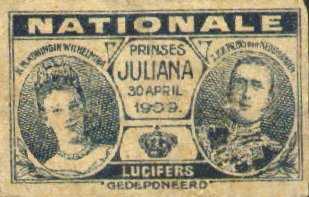Dutch history
For a view of the series of matchboxlabels and skillets that have been issued in the Netherlands since Worldwar II, see navigation for specific issues. It is only a small part of all the labels and skillets that are issed in the Netherlands since the first matches were sold.

The history of matchfactories in the Netherlands started around 1870. Over the years some new factories were founded and other factories merged. Most of these factories were closed between both worldwars.
After Worldwar II 3 factories still existed. In Eindhoven and Breda were two factories who formed the “V.H.L.F.” which stood for “Verenigde Hollandse Lucifers-Fabrieken” meaning “United Dutch Matchfactories”, part of Swedish Match.
In Weert stood the “Nationale lucifersfabriek” (national matchfactory).
In 1967 the “V.H.L.F.” took over the factory in Weert, and at the same time they closed the factory and also the one in Breda. Since then only the factory in Eindhoven was left. As a result of a reorganisation of the Swedish Match factories in Europe the last Dutch factory finally closed in 1980. The matchproduction moved to the Belgian UNAL factory in Geraardsbergen.
Since 1881 there is also a trading-company in Amsterdam, called “Attema”. First they traded Swedish matches, later they also became the selling-agent for the “V.H.L.F.”
Another trading-company, specialized in publicity-matches is “Atria”. In 1968 they became part of the Attema trading Co.. Nowadays Atria is specialized in booklets and luxury publicity boxes.
In April 1991 the names of Attema and Atria have officially changed into “Swedish Match Nederland b.v.”.
The amount of Dutch labels and skillets is enormous. From 1870 to 1945 it were mostly brand-labels, in a lot of variaties and most of them with packetlabels. A lot of Dutch brands have been exported and some of them are only issued abroad. In these years publicity-matches were not common only a few sets were issued. A lot pre-war labels have been documented, but undoubtedly some labels do not exist anymore and therefore will never be found.
After Worldwar II the economy was growing fast and soon the matchfactories started producing labels in various colours and the issueing of sets started.
In the Netherlands it was a chain of grocers-shops who first issed sets, and soon other followed, and the factories also began printing their own sets. As a result of this people discovered that the matchbox was an excellent publicity-article and therefore an enormous amount of publicity-labels have been issed over the years, not only to promote articles or companies, but also to prevent the use of alcohol, to raise money for clubs or good causes, or labels with the name of a restaurant or tobacconist. And besides the sets most grocers-shops and supermarkets have also issed lots of single labels or skillets and even nowadays every year some new ones are issed.
The first sets issed after Worldwar II were made by the Dutch factories. In the 1970’s some supermarkets started importing their matches from countries like Belgium, Hungary or Yugoslavia because they were cheaper. And of course since 1980 all matches sold in the Netherlands are made abroad.
On this site are the sets that were generally available all over the country. This means the sets issued by the factory (mostly sold in “independant” grocers-shops), the sets issued by the grocers-shops and supermarkets (with their own names on it) and a few sets of publicity-labels and -skillets.
Undoubtedly there will be some language-mistakes but I hope they won’t be too annoying and this list nevertheless will help collectors outside the Netherlands to organize their collection of Dutch labels and skillets and that it will encourage others to start collecting them.
